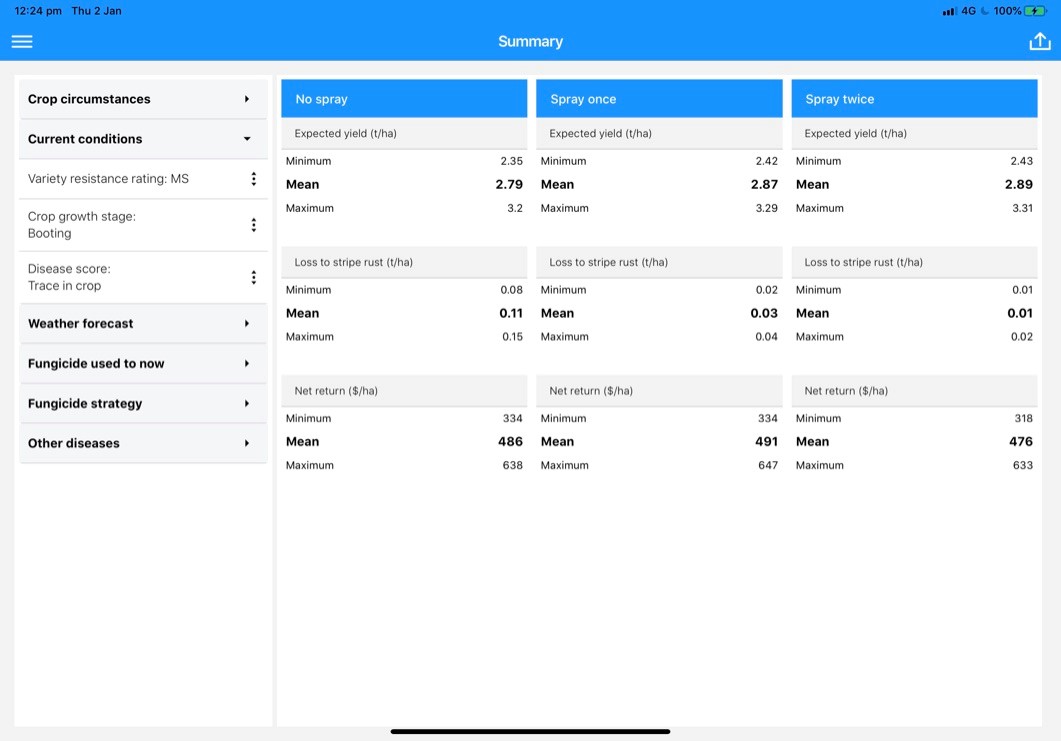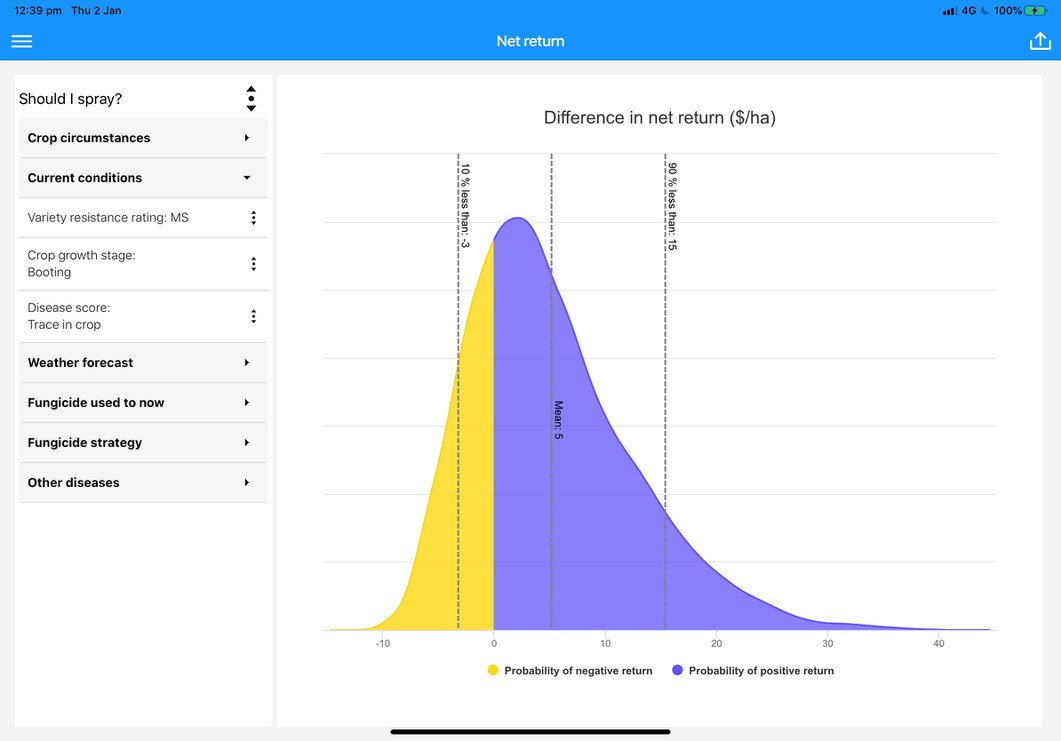Crop diseases – what to look out for in 2020?
Crop diseases – what to look out for in 2020?
Author: Josh Fanning, Mark McLean and Grant Hollaway (Agriculture Victoria) | Date: 22 Jul 2020
Take home messages
- Economic crop disease management relies on an integrated disease management strategy and consideration of yield potential and seasonal conditions.
- Disease ratings may change and it is important to consult the latest disease guide for the latest ratings and up to date disease management information.
Integrated Disease Management
A good integrated disease management strategy will incorporate:
- Diversity of crops within the paddock rotation.
- Avoidance of sowing into stubble from the same crop.
- Management of the green bridge.
- Avoidance of varieties with very susceptible ratings where possible.
- Monitoring for diseases at key growth stages.
- Consideration of seasonal conditions.
- Seeking assistance to identify diseases where required.
- Timely fungicide application.
- Knowledge of where and when to get help.
Disease ratings
There have been some important disease resistance rating changes in both pulses and cereals and it is always important to consult the latest disease guide to get the up to date ratings. These ratings indicate which varieties will require monitoring and in-season management with fungicides. Specifically, in pulses there is a revised set of pulse disease rating definitions to be familiar with. A summary of some disease rating changes is provided in the next section.
Pulse ratings
Several new varieties have recently been released with many providing improvements in resistance to diseases of importance in Victoria. A nationally standardised approach to pulse disease resistance ratings has now been implemented with new rating definitions (Table 1) and this has resulted in some minor changes to resistance classifications. With the changes in diseases over time it is always recommended to consult a current disease guide
Table 1. The updated pulse disease ratings used in the National Variety Trials which will be implemented in pulse ratings released during 2020 and onwards.
Rating Category | Definition | |
|---|---|---|
R | Resistant | No symptoms visible. No fungicides are required. |
RMR | Resistant to Moderately Resistant | The disease may be visible but will not cause significant plant damage or loss. However, under extreme disease pressure or highly favourable environments conditions fungicide applications may be required e.g. to prevent seed staining. |
MR | Moderately Resistant | The disease may be visible but will not cause significant plant damage or loss. However, under high disease pressure or highly favourable environments conditions fungicide applications may be required e.g. to prevent seed staining. |
MRMS | Moderately Resistant to Moderately Susceptible | The disease symptoms are moderate and may cause some yield and/or seed quality losses in conducive conditions. Fungicide applications, if applicable, may be required to prevent yield loss and seed staining. |
MS | Moderately Susceptible | Disease symptoms are moderate to severe and will cause significant yield and seed quality loss in the absence of fungicides in conducive seasons, but not complete crop loss. |
S | Susceptible | The disease is severe and will cause significant yield and seed quality loss, including complete crop loss in the absence of fungicides, in conducive conditions. |
VS | Very Susceptible | Growing this variety in areas where a disease is likely to be present is very high risk. Significant yield and seed quality losses, including complete crop loss can be expected without control and the increase in inoculum may create problems for other growers. |
Faba Bean
PBA Amberley has improved chocolate spot resistance, provisionally rated MR compared with the other commercial varieties. Preliminary field data is showing minimal yield losses due to chocolate spot, although currently there are few experiments with good levels of infection. Glasshouse results are also showing good resistance to Ascochyta blight pathotypes 1 and 2.
Lentil
PBA Highland XT has improved resistance to Ascochyta blight (rated MR), including the isolates in South Australia that are now compromising the resistance in PBA Hurricane XT and PBA Hallmark XT .
Wheat stripe rust
There is a risk of stripe rust development in 2020. There was a late outbreak of stripe rust in wheat crops during 2019, particularly in the variety LRPB Trojan due to the occurrence of a new pathotype. This could reoccur in 2020, so monitor wheat crops during late winter and spring.
A new stripe rust pathotype
During 2019, there were reports of stripe rust in the wheat varieties LRPB Trojan and DS Bennett at higher than expected levels. Data collected from the field during 2019 by NSW DPI and AgVic, as part of GRDC’s National Variety Trials (NVT) disease rating project, indicated that this new pathotype has implications for several wheat varieties, such as DS Bennett and LPB Trojan and to a lesser extent Devil, Illabo, DS Darwin, Emu Rock and Hatchet CL Plus. There were also implications for several durum varieties, such as DBA Spes, DBA Lillaroi, DBA Vittaroi and EGA Bellaroi.
It is important to consult a current disease guide to be aware of changes such as these.
Decision support for stripe rust control: StripeRustWM
A new tablet-based app, StripeRustWM, has been developed to support in-crop decision making for the management of stripe rust of wheat. The app is based on the already successful BlacklegCM and SclerotiniaCM apps that are widely used in canola. StripeRustWM estimates potential losses using information such as variety resistance rating, plant growth stage, fungicide history, presence of rust either within the crop or the district, climatic conditions, expected yield and economics. StripeRustWM was developed using data and information from the last 30 years’ national pathology research projects. The app will be updated annually with the latest research findings so that new information can be utilised by industry as soon as available.
StripeRustWM is designed to be quick to use in the field, to guide profitable decisions about stripe rust management. It has a straight-forward user interface that asks for inputs that can be readily estimated by agronomists.
Figure 1 illustrates the StripeRustWM app interface, where a trace of stripe rust has been detected in a crop with a resistance rating of moderately susceptible (MS), at the booting growth stage. The output shows that a marginally higher net return would be expected if fungicide was applied to the crop once, compared with not spraying. The net return would probably be lower if the crop were sprayed twice.

Figure 1. The summary view from StripeRust Wheat Management (StripeRustWM) comparing expected yield, loss to stripe rust and net return for the cases where fungicide is not applied, is applied once, or is applied twice.
An alternate presentation of the StripeRustWM app is shown in Figure 2, illustrating the range of possible outcomes, as a probability, from a single fungicide application. This reflects the variable nature of a biological system where a range of outcomes are possible. It shows the relative likelihood of positive and negative returns from the spray based on different environmental conditions and yield potentials.

Figure 2. The net return view from StripeRust Wheat Management (StripeRustWM) showing the distribution of expected net return resulting from a single fungicide application.
StripeRustWM is available at no cost for iPads or Android tablets from the Apple App Store or Google Play — search for ‘StripeRustWM’.
Fungicide resistance
Fungicide resistance is an important issue for the management of diseases in cereals. During the last 20 years fungicides have provided a cheap and reliable control of many fungal diseases, but their frequent use has resulted in a selection pressure which favours pathotypes that have mutations for fungicide resistance. Subsequently, there are increasing reports of diseases displaying reduced fungicide sensitivity and fungicide resistance. It is important that the agricultural industry adopts strategies that reduce reliance on fungicides to ensure their longevity.
During 2019, there were several reports of fungicide resistance in cereal diseases across Australia. The most significant was the identification of fungicide resistance in barley net form of net blotch (NFNB) to fluxapyroxad (a member of the SDHI group of fungicides) in the seed treatment Systiva®. This resistance was confirmed by the fungicide resistance researchers from the Centre for Crop and Disease Management at Curtin University in collaboration with SARDI in samples taken from multiple paddocks across the Yorke Peninsula (YP) in South Australia. Whilst testing for resistance to SDHI fungicides, a very high level of resistance to tebuconazole (used as an indicator of resistance within the DMI group of fungicides) was also detected in all 15 paddocks tested across the YP. Testing so far has focused on the YP but given the widespread dispersal of airborne spores, it is possible that spores of the dual-resistant pathotype of NFNB will have been dispersed during 2019 and may be present across a wider area, albeit at a low level during 2020. Further field testing is planned for 2020.
This development and spread of fungicide resistance for NFNB is likely to have been enhanced with the sowing of susceptible barley varieties into infected barley stubbles and the repeated use of fluxapyroxad (Systiva®) and a narrow range of DMI fungicides. This incidence highlights the importance of not becoming over-reliant on a single option for disease control.
The agricultural industry can slow the development of fungicide resistance and thus protect the longevity of the limited fungicides available by adopting the following disease management strategies;
- Use a range of control strategies to minimise disease development, including;
- avoid growing highly susceptible cultivars
- use crop rotation to avoid planting into paddocks with disease present
- manage the green bridge for diseases such as mildew and rust.
- Use seed and/or fertiliser treatments, if available, to suppress early disease development.
- Avoid unnecessary fungicide use.
- Use fungicide mixtures formulated with more than one mode of action.
- Do not use the same active ingredient more than once within a season.
- Adhere to label recommendations.
How can you help Pulse Pathology Research?
Samples of pulse crops with the following diseases are being sought:
- Ascochyta blight.
- Botrytis (BGM or chocolate spot).
- Sclerotinia.
- Soil-borne diseases.
Provision of these samples from the field ensures researchers are using the latest disease samples for monitoring changes in both the pathogen populations and variety resistance. If you can help, please contact Joshua Fanning (Victoria) for a collection kit that includes sample envelopes and a return post envelope.
Useful resources
- Pulse disease guide
- Cereal disease guide:
- Field Crop Diseases Victoria website
- National Variety Trial (NVT) website
- Victorian crop sowing guide
Acknowledgements
This research was made possible with investment from the Grains Research and Development Corporation (GRDC) and Victorian Government. The research undertaken here is made possible by the significant contributions of growers and agronomists through both trial cooperation and provision of diseased plant materials for the isolate collection as well as the support of the GRDC, the authors would like to thank them for their continued support.
Thanks to Agriculture Victoria’s field crop pathology team; Graham Exell, Jordan McDonald, Glenn Sluggett, Jon Baker, Melissa Cook, Hari Dadu, Luise Sigel, Jennifer Cutajar, Zoe Nicholson, Bhanu Kalia, Rajandeep Singh and Winnie Liu Heang. Thanks also to the Birchip Cropping Group for field trials within the Victorian Mallee. We also thank Jason Brand and the Southern Pulse Agronomy team for assistance with the pulse disease research
Contact details
Joshua Fanning
Agriculture Victoria
Private Bag 260, Horsham VIC 3401
03 5344 3335
Joshua.fanning@agriculture.vic.gov.au
@FanningJosh_
Mark McLean
Agriculture Victoria
Private Bag 260, Horsham VIC 3401
03 4344 3111
mark.s.mclean@agriculture.vic.gov.au
@msmclean777
GRDC Project Code: DJP1097-001RTX, CUR00023, DAV1706-003RMX, UA00163, DAS1905-013SAX, DJP1907-004RTX, DJP1905-002SAX, DAW1810-007RTX, DJP1907-002RMX, CUR1905-001SAX,
